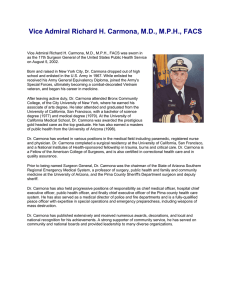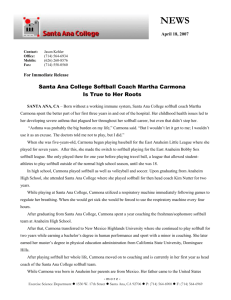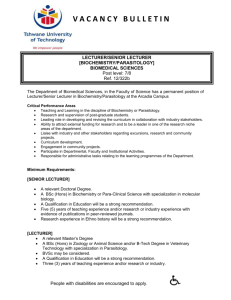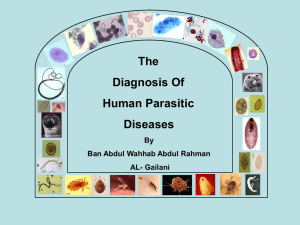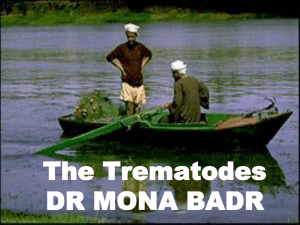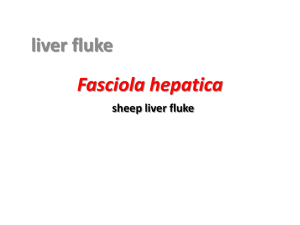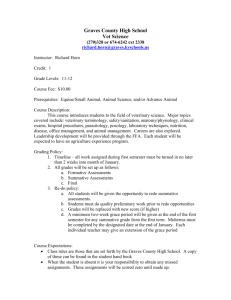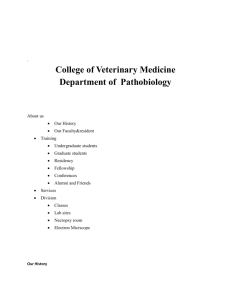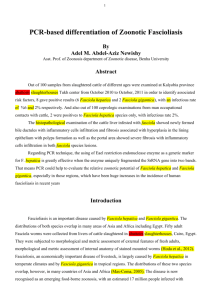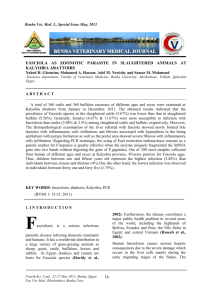Cancela, M., Carmona, C., Rossi, S., Goñi, F., Berasain, P. (2004)
advertisement
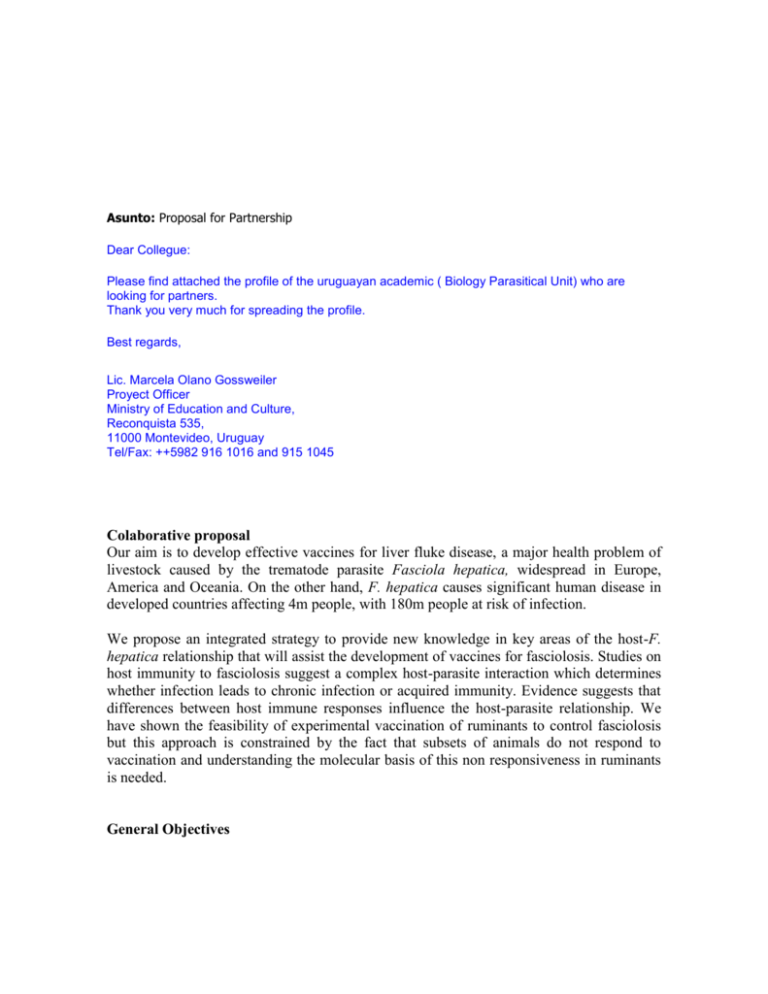
Asunto: Proposal for Partnership Dear Collegue: Please find attached the profile of the uruguayan academic ( Biology Parasitical Unit) who are looking for partners. Thank you very much for spreading the profile. Best regards, Lic. Marcela Olano Gossweiler Proyect Officer Ministry of Education and Culture, Reconquista 535, 11000 Montevideo, Uruguay Tel/Fax: ++5982 916 1016 and 915 1045 Colaborative proposal Our aim is to develop effective vaccines for liver fluke disease, a major health problem of livestock caused by the trematode parasite Fasciola hepatica, widespread in Europe, America and Oceania. On the other hand, F. hepatica causes significant human disease in developed countries affecting 4m people, with 180m people at risk of infection. We propose an integrated strategy to provide new knowledge in key areas of the host-F. hepatica relationship that will assist the development of vaccines for fasciolosis. Studies on host immunity to fasciolosis suggest a complex host-parasite interaction which determines whether infection leads to chronic infection or acquired immunity. Evidence suggests that differences between host immune responses influence the host-parasite relationship. We have shown the feasibility of experimental vaccination of ruminants to control fasciolosis but this approach is constrained by the fact that subsets of animals do not respond to vaccination and understanding the molecular basis of this non responsiveness in ruminants is needed. General Objectives We will compare the RNA/protein signatures associated with natural acquired immunity in susceptible sheep and compare these with signatures in vaccinated sheep to study variations in vaccine-induced protective immunity. We will define the ESTs and proteome of the juvenile stages of both Fasciola hepatica, and compare these datasets to identify cDNAs/proteins expressed which may contribute to immune evasion mechanisms of Fasciola: such molecules represent novel vaccine or drug targets. Novel and existing candidate vaccines developed in our laboratory such as leucine aminopeptidase (LAP) and thiredoxin glutathione reductase (TGR) will be further validated, optimised and tested in sheep and cattle: mucosal delivery of vaccines in live vectors will be assessed. Recent publications Piacenza, L., Acosta, D., Basmadjian, I., Dalton, J.P., Carmona, C. (1999) Vaccination with cathepsin L proteinases and with leucine aminopeptidase induces high levels of protection against fascioliasis in sheep. Infection and Immunity 67, 1954-1961. Berasain, P., Carmona, C., Frangione, B., Dalton, J., Goñi, F. (2000) Interaction of Fasciola hepatica proteases with human IgG subclasses. Basis of parasite subversion of the humoral immune response. Experimental Parasitology 94, 99-110. Torgerson, P. R., Carmona, C. and Bonifacino, R. (2000) Estimating the economic effects of echinococcosis: Uruguay an upper middle income developing country. Annals of Tropical Medicine and Parasitology, 94, 703-713 Alvarez, D., Medeiros, A., Míguez, M., Casaravilla, C., Malgor, R., Carmona, C., Nieto, A. Osinaga, E. (2001) O-glycosylation in Echinococcus granulosus: Identification and characterisation of the carcinoma associated Tn antigen. Experimental Parasitology, 98, 100-109. Carnevale, S., Rodríguez, M., Guarnera, E., Carmona, C., Tanos, T. Angel, S. (2001) Inmunodiagnosis of fasciolosis using recombinant procathepsin L cysteine proteinase. Diagnositic Microbiology and Infectious Disease, 41:43-49. Touz, C., Nores, M., Slavin, I., Carmona, C., Conrad, J., Mowatt, M., Nash, T., Coronel., C., Lujan, H. (2002) The activity of a developmentally regulated cysteine proteinase is required for cyst wall formation in the primitive eukaryote Giardia lamblia, Journal of Biological Chemistry 277, 8474-8481. Touz, C., Nores, M., Slavin, I., Piacenza, L., Acosta, D., Carmona, C., Luján, H. (2002) A membraneassociated dipeptidyl peptidase IV-homolog is involved in encystation-specific gene expression during Giardia differentiation. The Biochemical Journal 364, 703-710. Bentancor, A, Piacenza, L., Carmona, C. (2002) Immunization with cathepsin L proteinases CL1 y CL2 secreted by Fasciola hepatica elicit a preferential type 1 response based on IgG2a antibodies in rats. Journal of Helminthology 76, 199-207. Freire, T., Casaravilla, C., Carmona, C., Osinaga, E. (2002) Mucin type O-glycosylation in Fasciola hepatica: characterization of carcinoma associated Tn and sialyl-Tn antigens and evaluation of UDPGalNAc:polypeptide-acetylgalactosaminyltransferase activity. International Journal for Parasitology 33, 47- 56. Freire, T., Robello, C., Casaravilla, C., Medeiros, A., Carmona, C., Osinaga, E. (2002) Antígenos mucínicos de O-glicolisación simple: nuevas similitudes moleculares entre células cancerosas y parásitos. Actas de Fisiología de la Facultad de Medicina, 8, 89-107. Casaravilla, C., Malgor, R., Carmona, C. (2003) Characterization of carbohydrates of adult Echinococcus granulosus by lectin binding analysis. Journal of Parasitology. 89, 57-61. Casaravilla, C., Freire, T., Malgor, R., Medeiros, A., Osinaga, E, Carmona, C. (2003) Mucin-type O-glycosylation in helminth parasites from major taxonomic groups: evidence for widespread distribution of the tn antigen (GalNAc-Ser/Thr) and identification of UDP-GalNAc:polypeptide nacetylgalactosaminyltransferase activity. Journal of Parasitology. 89, 709-714. Berasain, P., Carmona, C., Frangione, B., Cazzulo, J.J., Goñi, F. (2003) Specific cleavage sites on human IgG subclasses by cruzipain, the major cysteine proteinase from Trypanosoma cruzi. Molecular and Biochemical Parasitology 130, 23-29. Moreno, M., Benavídez, U., Carol, H., Rosenkranz, C., Welle, M., Carmona, C., Nieto., A., Chabalgoity, J.A. (2004) Local and systemic immune responses to Echinococcus granulosus in experimentally infected dogs. Veterinary Parasitology 119, 37-50. Cancela, M., Carmona, C., Rossi, S., Goñi, F., Berasain, P. (2004) Purification, characterization and immunolocalization of paramyosin from the adult stage of Fasciola hepatica. Parasitology Research 92, 441-448. Maggioli, G., Piacenza, L., Carámbula, B., Carmona, C. (2004) Purification and characterisation of a thioredoxin reductase from Fasciola hepatica. Journal of Parasitology 90, 205-211. Oku, Y., Malgor, R., Benavidez, U., Carmona, C., Kamiya, M. (2004) Control program against hydatidosis and the decreased prevalence in Uruguay. International Congress Series 1267, 98-104. Casaravilla, C., Malgor, R., Rossi, A., Sakai, H., Nonaka, N., Kamiya, M., Carmona, C. (2005) Production and characterization of monoclonal antibodies against excretory / secretory products of adult Echinococcus granulosus, and their application to coproantigen detection. Parasitology International 54, 43-49. Bessonart, M. E., Macedo, N., Carmona, C. (2005) High resolution B-scan ultrasound of hypertrophic scars. Skin Research and Technology 11; 185-188. Ubillos, L., Medeiros, A., Cancela, M., Casaravilla, C., Saldaña, Y., Domínguez , L., Carmona , C., Le Pendu, J. ,Eduardo Osinaga. (2007) Characterisation of the carcinoma associated Tk antigen in helminth parasites. Experimental Parasitology. Doi.10.1016/jexppara.2006.12.009.
